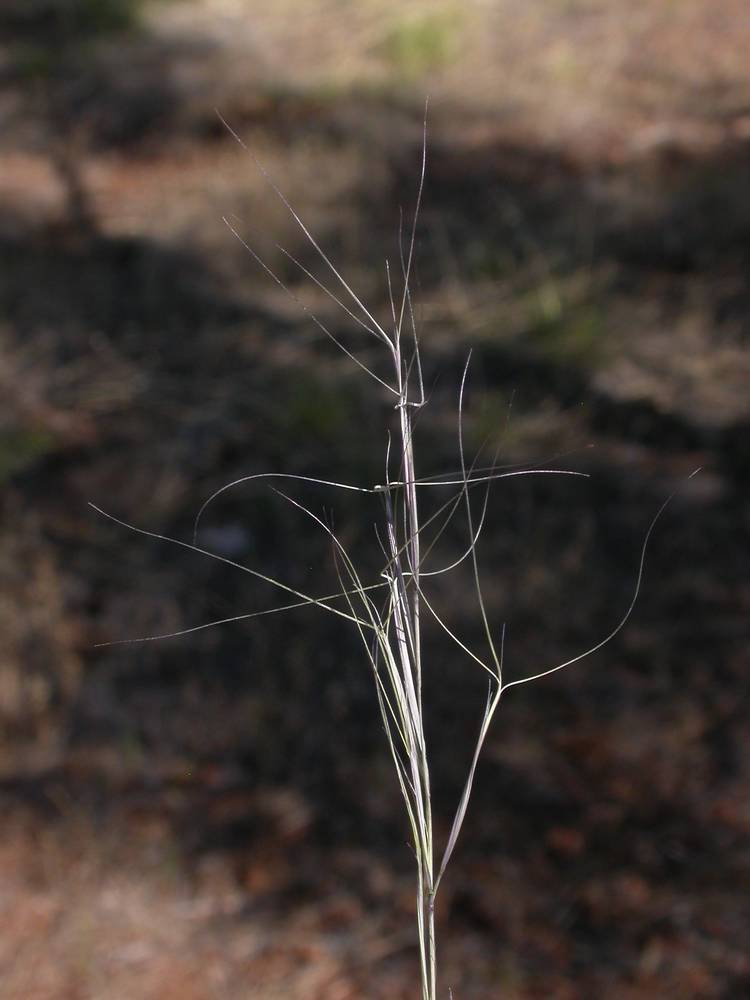Aristida adscensionis
Aristida
sixweeks three-awn
three-awn
much branched above the base, with solid internodes.
erect or bent at base, usually pith-filled, sometimes hollow;
nodes glabrous or with straight hairs less than 0.5 mm.
sheaths glabrous;
ligules about 0.5 mm, with a fringe of dense hairs;
blades 2–14 cm × 1–2.5 mm; flat to involute.
basal and cauline;
sheaths open, ligules of hairs or membranous with marginal cilia;
blades flat to involute.
panicles, 5–15(20) × 0.5–3 cm;
branches erect to ascending.
panicles, sometimes racemes or spikes.
5–8 mm.
with 1 floret;
florets terete or weakly laterally compressed;
disarticulation above the glumes.
subequal to lemmas, 1-veined, glabrous, acuminate to short-awned;
lower glumes 4–8 mm;
upper glumes 6–11 mm.
2, often longer than the florets; thin; acute to acuminate;
glume awns; if present, arising between 2 slender inconspicuous hyaline teeth.
fusiform.
0.5–0.8 mm; hairy.
hairy, often sharp.
6–9 mm, 3-veined; leathery;
midveins scabrous, glabrous elsewhere;
lemma awns 3; the central awn 7–15(20)mm; the lateral awns somewhat shorter, occasionally only 1–2 mm, flattened near the base; straight to somewhat curved.
3-veined, hardened; terete, enclosing the palea at maturity.
3, 0.3–0.7 mm.
1 or 3.
3, arising at the tip of the lemma, ascending, spreading, sometimes coiled or contorted, persistent or disarticulating at maturity, subequal or sometimes the 2 lateral awns reduced to short teeth.
=22, 33, 44.
Aristida adscensionis
Aristida
Waste ground, roadsides, degraded rangelands, and dry hillsides, often in sandy soils. 800–1200m. Lava. CA, ID, NV, WA; southwestern states and scattered elsewhere in US; South America. Exotic.
Tropical to warm-temperate regions of the world. Approximately 250–300 species; 3 species treated in Flora.
Aristida populations often increase in size when associated with heavy grazing. The awns aid in dispersal on animal fur and by wind and also help with seedling establishment by driving the seeds into the soil as the awns twist with changes in humidity. The awns and the sharp callus can harm grazing animals.
Barbara Wilson, Richard Brainerd, Nick Otting
Barbara Wilson, Richard Brainerd, Nick Otting
- Local floras:
CA,
OR,
WA
- Local Web sites:
CalFlora,
CalPhotos,
Flora NW,
PNW Herbaria
WildflowerSearch
iNaturalist (observations)
USDA Plants Database
- LBJ Wildflower Center
- SEINet
- Plants of the World Online
- Encyclopedia of Life
- Wikipedia
- Google Image Search



